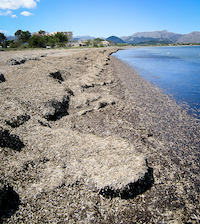ABSTRACT
Macroalgal mass blooms and accumulating beach-cast are increasing problems in many coastal areas. However, beach-cast is also a potentially valuable marine bioresource, e.g. as a biofertiliser in coastal agriculture. One limiting factor in use of beach-castas a fertiliser is uncertainty regarding the cadmium (Cd) concentration depending on beach-cast composition and location.
In this study, chemical analyses were performed on beach-cast from Burgsviken Bay in the island of Gotland, in the Baltic Sea. The results revealed large variations in cadmium concentration depending on sampling location and beach-cast composition, with levels ranging between 0.13 and 2.2mg Cd/kg dry matter (DM). Of 15 beach-cast samples analysed, one had a cadmium content above the Swedish statutory limit for biofertiliser (2mg Cd/kg DM) and four had values above the limit suggested by the Swedish Environmental Protection Agency for 2030 (0.8mg/kg DM).
Species-specific analysis revealed that eelgrass (Zostera marina) contained significantly higher cadmium concentrations than filamentous red algae species (Ceramium and Polysiphonia spp.). Avoiding eelgrass-rich beach-cast by seasonal timing of harvesting and monitoring differences in cadmium concentrations between harvesting sites could thus facilitate use of beach-cast as biofertiliser.








